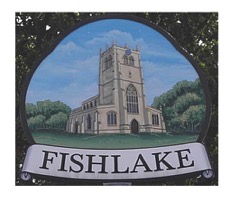CUTHBERT’S HAVEN. Fishlake and the St Cuthbert connection.
So far there are three pieces of evidence directly linking St Cuthbert to Fishlake village.
The church dedication, reference to Cuthbert’s Haven in 1416 agreement and the naming of the village cross.
THE SAINT OF DEDICATION
St Cuthbert, patron saint of the parish church, and the legendary resting place of his body during the 9 th century.
The background to St Cuthbert story, according to the Venerable Bede, is that Cuthbert’s sarcophagus was opened eleven years after his death in 687, his body was found to be perfectly preserved or incorrupt. This apparent miracle followed by other miracles has led to the growth of a St Cuthbert’s cult in the North of England surrounding this venerated and important saint. However later to protect his remains from invading Danes in 875 a coffin containing the body of St Cuthbert was taken by monks from Lindisfarne, now know as Holy Island, down the coast and up the Humber estuary into Yorkshire. These monks travelled with their holy burden throughout the county and northward to Co Durham for seven years where his body finally came to rest. These monks could not have failed to pass through various Yorkshire settlements on his way northward. Consequently it is not surprising that places were his body may have rested have been given an historical and indeed special connection to St Cuthbert. There is available to the public a great many accounts of St Cuthbert’s life and ‘wandering’ after his death in various publications for those who want to read more.
In 1416 Prior Wessington of Durham draw up a list of parishes which were thought to identify the resting places of St Cuthbert during the ‘wandering’ but in fact they are simply names of parishes with a special connect to Durham, Fishlake of cause being one.
Canon George Ornsby, vicar of Fishlake 1850-1886 discovered at Durham a document (now lost) which he copied down. In an agreement, dated the 22 September 1416 between the Prior and Convent of Durham and "Richard Wryghte of Fyyshlake, yeoman," the latter becomes tenant under that body of a piece of ground forming a portion of the garden of the Rectory of Fishlake-
"gua quidem parcella jacet inter residuans partem predict gardini rectoria de Fyyshlake ex parte orientali, quendam locum vulgariter vocatum CUTHBERTEHAVEN ex parte occidentali, et inter pratum rectoria ecclesizi predicts ex parte australi, et cimiterium ejusdem ecclesia ex parte boriali.
Translated as….
"This parcel lies between the remaining part of the aforesaid rectory garden of Fyshlake on the eastern side, a certain place commonly called CUTHBERTEHAVEN on the western side, and between the meadow of the aforesaid rectory church on the southern side, and the cemetery of the same church on the northern side."
This 'Cuthbert Haven' was well known to the parishioners of Fishlake in the 18 th century, for we are told by the well respected antiquarian of South Yorkshire, Rev Joseph Hunter in a letter he sent concerning this matter to Canon Ornsby, although Rev Ornsby found no trace of any such tradition in the village during his incumbency after 1850.
However, the position of the Haven has been generally thought to be what is now known as ‘The Landing’ an area adjacent to the former course of the River Don. Historically this area was used for riverside business also known in old documents and maps as a quay or Staith, ideally situated for such purposes since early times. One reference to a haven appears in the village Bylaw Book in May 23 rd 1667 “The bylaw being sumined to mete to Gether at hayven cros the day above written to serve the somses in the bylaw feild and Inges”
So it appears that this cross was known at this time, at any rate, as Haven Cross which lies close by the Landing, now known as the Butter Cross.
